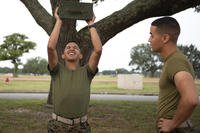Are you struggling to pace yourself during timed events? Too many people start off too fast and don't get the results they wanted.
In an initial running assessment, I recently tested timed runs of 1.5 miles (Air Force/Navy), two miles (Army) and three miles (Marine Corps). All were part of a group of military and special ops candidates. Most ran the first quarter-mile in under 90 seconds, leading to a six-minute mile pace or timed runs of nine minutes for 1.5 miles, 12 minutes for two miles and 18 miles for three miles.
Only a few broke nine minutes/12 minutes, but more than half of the group scored between 10:30-12:00 on the 1.5-mile run and 14 minutes on the two-mile run (seven-minute mile pace). The 18-minute, three-mile goal was not even closely reached with USMC recruits running 21-22 minutes for their first timed-run test. Many candidates could not maintain their six-minute mile pace for the entire test distance.
What does that tell us? They need to work on their aerobic base, paced running maintenance/endurance, and they start out too fast for their current abilities.
When it comes to running and other longer distance events, it's important to learn how to pace yourself. If you start off too fast, you won't keep that pace throughout the entire event. This can lead to frustration and even failure, but it can be easily corrected with a few workout sessions.
It's easy to get caught up in the moment, feel the test-taking anxiety/adrenaline and start off with the pack, but the majority of those who run too fast are usually lapped in a 1.5- to three-mile timed run.
To help you with your pacing progressions when you run, here is a goal pace chart:
Goal Pace Chart
| Goal Pace and Distance/Time | 8-minute mile pace | 7-minute mile pace | 6-minute mile pace |
| Test Time Goal | 12-minute, 1.5-mile run | 10:30 1.5-mile run | 9 minute, 1.5-mile run |
| Pace quarter-mile | 2:00 | 1:45 | 1:30 |
| Pace half-mile | 4:00 | 3:30 | 3:00 |
| Pace three-quarter-mile | 6:00 | 5:15 | 4:30 |
| Pace one mile | 8:00 | 7:00 | 6:00 |
Running Workout Ideas
Goal-Paced Running -- This means running your timed-run event. If your current score is a 12-minute, 1.5-mile timed run, for example, that means you run at an eight-minute mile pace. Your next goal should be learning how to run at a seven-minute mile pace. Looking at the chart above, you can create the following running workout spread throughout the week to incorporate your learning how to run at this new pace:
Repeat six times.
- Run a quarter-mile at goal pace (1:45).
- Walk 100 yards as rest.
If this is easy, either do 10-12 sets or increase the distance for each set and run a half-mile at your goal pace like this the next run day:
Repeat 3-4 times.
- Run a half-mile at goal pace (3:30).
- Walk 200 yards as rest.
If you are new to running, there is no need to run every day. In fact, running every other day may be a better option if you are not used to running 2-3 miles a day. Try mixing in a different type of cardio on the days in between so you can still work the aerobic base without the impact pain that often finds new runners.
Biking, elliptical, rowing or swimming are great nonimpact examples to add to your cardio training if you need to work the heart and lungs but are susceptible to shin splints, knee tendinitis and other running overuse injuries.
If you are just starting to break an eight-minute mile pace, building up to a seven-minute mile may be a challenge but start trying with 1:45 quarter-miles for several sets. Once that becomes easy, add half-mile interval sets and even full-mile sets. Eventually, you will maintain that pace for the entire timed run. That is goal-pace running.
Related articles on pacing, aerobic base and timed-run tests:
- Running Hills for Training
- Running Workout Ideas for Timed Runs and Aerobic Base
- Is Running a Weakness? Start Here
Stew Smith is a former Navy SEAL and fitness author certified as a strength and conditioning specialist (CSCS) with the National Strength and Conditioning Association. Visit his Fitness eBook store if you're looking to start a workout program to create a healthy lifestyle. Send your fitness questions to stew@stewsmith.com.
Want to Learn More About Military Life?
Whether you're thinking of joining the military, looking for fitness and basic training tips, or keeping up with military life and benefits, Military.com has you covered. Subscribe to Military.com to have military news, updates and resources delivered directly to your inbox.




















